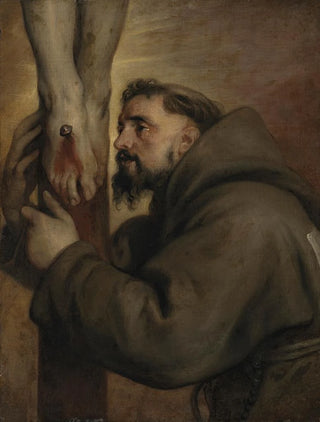Art print | Saint François d'Assise at the foot of the Cross - Antoine van Dyck


View from behind

Frame (optional)
The artwork "Saint Francis of Assisi at the Foot of the Cross" by Antoine van Dyck is a masterpiece that evokes spirituality and devotion from one of the most revered saints in Christianity. This depiction, both poignant and introspective, immerses us in a universe where suffering and faith intersect in a striking manner. Van Dyck, known for his skill in capturing human emotions, succeeds here in conveying an atmosphere of contemplation and meditation. By contemplating this piece, the viewer is invited to share in the saint's intimacy, to feel the depth of his surrender and the light emanating from his unwavering faith.
Style and uniqueness of the artwork
Van Dyck's style is characterized by an exceptional mastery of light and color, which give his compositions an almost lifelike dimension. In "Saint Francis of Assisi at the Foot of the Cross," the artist uses dramatic lighting to emphasize the features of the saint's face, highlighting his expression of suffering and serenity. Shades of brown and gold create a warm atmosphere, while emphasizing the contrast between the cross and the saint's figure. This work also stands out for its carefully balanced composition, where each element, from the saint's body to the details of the surrounding landscape, contributes to a visual harmony that captivates the eye. The posture of Saint Francis, humble and resigned, evokes deep spirituality, while the dark background accentuates the brightness of his presence.
The artist and his influence
Antoine van Dyck, a pupil of Rubens, left a mark on art history with his flamboyant Baroque style and his ability to portray nobility and spirituality with great finesse. His influence extends well beyond his era, inspiring many artists across Europe. With "Saint Francis of Assisi at the Foot of the Cross," he demonstrates a profound understanding of religious themes, while incorporating portrait elements that humanize the saint. Van Dyck manages to establish a link between the sacred and the profane, making his characters accessible and touching. This innovative approach opened

Matte finish

View from behind

Frame (optional)
The artwork "Saint Francis of Assisi at the Foot of the Cross" by Antoine van Dyck is a masterpiece that evokes spirituality and devotion from one of the most revered saints in Christianity. This depiction, both poignant and introspective, immerses us in a universe where suffering and faith intersect in a striking manner. Van Dyck, known for his skill in capturing human emotions, succeeds here in conveying an atmosphere of contemplation and meditation. By contemplating this piece, the viewer is invited to share in the saint's intimacy, to feel the depth of his surrender and the light emanating from his unwavering faith.
Style and uniqueness of the artwork
Van Dyck's style is characterized by an exceptional mastery of light and color, which give his compositions an almost lifelike dimension. In "Saint Francis of Assisi at the Foot of the Cross," the artist uses dramatic lighting to emphasize the features of the saint's face, highlighting his expression of suffering and serenity. Shades of brown and gold create a warm atmosphere, while emphasizing the contrast between the cross and the saint's figure. This work also stands out for its carefully balanced composition, where each element, from the saint's body to the details of the surrounding landscape, contributes to a visual harmony that captivates the eye. The posture of Saint Francis, humble and resigned, evokes deep spirituality, while the dark background accentuates the brightness of his presence.
The artist and his influence
Antoine van Dyck, a pupil of Rubens, left a mark on art history with his flamboyant Baroque style and his ability to portray nobility and spirituality with great finesse. His influence extends well beyond his era, inspiring many artists across Europe. With "Saint Francis of Assisi at the Foot of the Cross," he demonstrates a profound understanding of religious themes, while incorporating portrait elements that humanize the saint. Van Dyck manages to establish a link between the sacred and the profane, making his characters accessible and touching. This innovative approach opened






